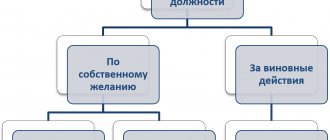An order to introduce a new position into the staffing table is a required document when introducing a new work unit (or several).
- Form and sample
- Free download
- Online viewing
- Expert tested
FILES
ShR is one of the forms of protecting the rights of employees from arbitrary dismissal. It documents the structure of the enterprise and determines the list of positions and salaries of employees. Often in a developing team there is a need to create a new work unit that is not provided for by staff documents. To do this, the manager issues an order to introduce a new workplace into the established workforce.
Procedure for issuing an order
The need to make changes to the company structure may arise:
- as a result of the introduction of a new line of activity;
- when attracting new specialists due to modernization of production;
- due to job cuts;
- in connection with an increase or decrease in salaries, etc.
Labor legislation does not establish any special requirements for the timing and procedure for making changes to the company structure. Therefore, these issues are left to the discretion of the manager. If an organization needs to create a new department or other structural unit, then it is advisable to change the staffing table itself. If you need to add a new staffing position, it is quite enough to change the personnel schedule by issuing a corresponding document.
An order to introduce a new position can be developed by order of the head of the organization:
- personnel service;
- lawyers;
- secretary.
When developing such an order it is necessary:
- Analyze general information:
- about job responsibilities;
- about optimal time costs;
- on the hourly standards provided for the corresponding type of work.
- Decide on the acceptable hourly workload (rate, 0.5 or 0.25 rate or less) for a new employee.
- Develop a draft job description.
- Prepare a proposal addressed to management to increase staff. It can be sent on behalf of:
- head of the personnel department;
- the head of the department to which the new unit is proposed.
- Develop an order form.
The memo provides all the statistical data that was obtained to justify the optimality of establishing new positions.
If a new structural unit is introduced into a company department, the memo must be signed by the head of the relevant department.
An internal memo about the need to introduce a new workplace is drawn up by the head (or specialist) of the HR department:
- if the new official will report to the manager;
- if the employee is not related to any structural unit.
An order for the introduction of a new staff unit and detailed instructions describing the responsibilities of the new employee are attached to the memo as an appendix. After the employer approves the proposals set out in the memorandum, he signs an order to introduce a new position into the staffing table.
How to properly onboard a new employee
You tell them about your methods of work and introduce them to the people they will work alongside. In other words, new employees should get a general idea of the activities and state of your enterprise.
It is worth spending the necessary amount of time on all the questions listed above. If a new employee feels welcome from the very beginning and feels part of your team, he will perform better. This way he will become an active member of your work team much faster. All costs associated with onboarding new employees are an investment in the development of your business.
Is it necessary to draw up an action plan related to the introduction of new employees?
If you don't explain everything related to his position to the new employee from the very beginning, he will torment you with endless questions. He will spend not only his time on this, but also yours.
Without an appropriate induction plan, you will explain everything to the new employee unclearly and inconsistently, touching on one side or the other of his future activities. As a result, some important points may be overlooked, and errors may not be excluded. A haphazard, illogical introduction to the position will subsequently result in ineffective work of the new employee.
All this can be avoided if you clearly, clearly and consistently explain to the new employee what he must do from the very beginning. As a result you:
- save the new employee from having to ask too many questions;
- significantly reduce the risk associated with incorrect actions of a new employee due to ignorance of any issues;
- you will be able to insure yourself against such mistakes that may result in large material losses and dangers for you in the future;
- help the new employee feel involved in the common cause;
- give the new employee the opportunity to quickly get into work and achieve the maximum degree of efficiency in his work activity.
The specific procedure for onboarding will depend on the position of the new employee. Below we will talk about what you should pay attention to, regardless of what your new employee will be doing.
Common questions related to onboarding a new employee
You will need to show the new employee the production or office premises, as well as solve a number of natural administrative and technical issues. It is necessary to explain to the new employee:
- where to have lunch;
- where and when you can drink tea or coffee (if this is practiced at your enterprise);
- where everything is located in your premises;
- Is it possible to smoke here and where?
- I am looking for the restroom;
- when, where and how salaries will be paid;
- to whom and how should one report illness or forced absence from the workplace (for example, to a secretary by telephone);
- where you can park the car (if necessary);
- what to do in case of fire.
This list could be continued. Write down those items that are most relevant to your type of business.
When introducing a new employee to a position, it may make sense to once again remind him of the basic terms of the employment contract. You've likely raised these questions during your interview. It's about:
- about wages;
- about financial incentives;
- about deductions from wages;
- about working hours;
- about overtime work;
- about vacation;
- on compensation of expenses;
- about holidays;
- on payment of sick leave;
- on compliance with labor discipline;
- about special conditions and nature of work.
Check the box next to those items that are directly related to the activities of your company.
Let's say you hire a new employee. What would you tell him before he starts his official duties? Write down your thoughts on this matter.
Before introducing a new employee to the details of his work, tell him about your business activities in general. It will probably be useful for a new employee to know:
- what does your company do;
- what types of goods or services it offers;
- who are your clients?
- how your enterprise operates as a whole, and why you are pursuing this business policy;
- what image do you want to create for your company (for example, is your company traditional, or is it developing new technologies);
- what your competitors are and how you manage to stay ahead of them;
- what do you think about entrepreneurial activity and what do you expect from your employees in this regard;
- what relationships and traditions have developed in your work team.
Now the new employee can ask you questions that interest him. Don't forget to tell the new employee about the basic house rules. Be sure to explain to him what these rules are based on. Try to write down the main issues that need to be addressed to the new employee.
Specific issues related to the introduction of a new employee
Now let's turn our attention to more specific issues. You helped a new employee get a general idea of the business activities of your enterprise. Now is the time to show your new employee his place in the structure of your enterprise. In other words, the new employee must clearly know his area of work.
If his work involves the use of complex or dangerous equipment, it is necessary to familiarize the employee with safety rules. The responsibility for this falls primarily on you.
Perhaps at first the new employee will gain experience. In this case, you need a person to whom a new employee can turn if necessary and ask questions that interest him. Figuratively speaking, at first, someone should take the new employee “under their wing.” Who do you think would be a good mentor for a newbie? If you're only hiring one or two new employees, you can probably take care of them yourself.
Try to list all the specific issues related to the introduction of a new employee. These could be the following questions:
- What specific work must a new employee do on a daily basis?
- What should you agree on with a new employee?
- What hardware will it work on?
- Who will he work with?
- To whom will he report on the work done?
These are not all possible questions. Write down all those private questions that are related to the introduction of a new employee and take into account the specifics of your business.
What to do after onboarding a new employee
Onboarding a new employee takes from one day to several weeks. Immediately after being inducted into the position, the new employee must begin to perform at least his basic job duties.
We should not forget that at first everything will be new to him. Don't lose sight of the new employee. Although upon introduction to the position the new employee received the minimum information necessary for work, still be prepared for additional questions. Let the new employee not be afraid to ask a question that interests him once again.
Both you and the new employee are equally interested in him quickly fitting into the new work team. You should not hope that the new employee will immediately remember and master everything. Be patient!
Provide the new employee with ongoing assistance and support. He will cope with his job responsibilities much better if he feels like part of a single team.
If a new employee has thoroughly grasped the principles of your work and understands what is required of him, he begins to feel a sense of increased responsibility. Gradually he will become a very useful member of your work team.
Monitoring and evaluating the work of a new employee
The onboarding of a new employee is not limited to one week. You must be sure that he has learned your lessons well. For this purpose, it is necessary to monitor its work weekly.
Write down the main parameters of the new employee's work (for example, skill level, style of working with clients, adherence to work discipline) and note how well he meets the specified parameters. This will help you evaluate the quality of the new employee's work. In addition, it will immediately become clear to you exactly how to direct the work activity of a new employee.
New employees without work experience
It is possible that your new employee may have no experience in this field or no experience at all. In this case, it is necessary to take this circumstance into account and accordingly draw up an action plan related to the introduction of a new employee.
You must remember that what he will have to do with you will be quite different from what he was taught at school or higher education, or from what he did previously. In this case, you will need a certain amount of tolerance and understanding. You definitely need to be patient: what you think are elementary things may turn out to be completely unfamiliar to a high school graduate or yesterday’s unemployed person. In this regard, the process of introducing a new employee into a position can take a significant amount of time.
At the same time, you may have to show toughness and rigor in order to once and for all eradicate from the new employee those bad habits and habits that could adversely affect the development of your enterprise and create difficulties in relations with clients and business partners.
You can hire a high school graduate on the condition that after work he will take special courses in the basics of entrepreneurship. In addition, you can set aside a certain time during the working day for a new employee to study by correspondence, so that he can attend one of the higher educational institutions, increasing the level of his education.
All this will take time and money, but the result will be a more qualified and better trained employee.
Source: Business Inside and Out
Order structure
Labor legislation does not contain an approved form of document on the introduction of a new position. Based on the analysis of the requirements for personnel documentation, we can conclude that the order should indicate:
- name of the organization (as in the constituent documents);
- city of compilation, number and date of compilation;
- name of the order (for example: “Order on the introduction of a new position in the staffing table”, “Order on the inclusion of a new position”, etc.);
- the basis for increasing the number of employees (for example, a memo, results of static analysis, etc.);
- Job title;
- the number of units needed to complete the available amount of work;
- the amount of the official salary.
- persons responsible for executing the order (this may be an accountant or a personnel employee).
The document must be signed by the manager or an authorized deputy. The signed form is sent to the HR department, and its copies are sent to the accounting service and departments in which these specialists will work.
How can the head of an organization justify the need to create a preschool education service?
I am the only one in charge of office work at the enterprise. The organization is growing, at the moment the number is almost 600 people, and the volume of work is growing accordingly.
It becomes more and more difficult to cope alone. It is necessary to competently draw up a memo to the manager and justify the need to create a preschool educational institution service.
How to do it? I am the only one in charge of office work at the enterprise. The organization is growing, at the moment the number is almost 600 people, and the volume of work is growing accordingly. It becomes more and more difficult to cope alone.
It is necessary to competently draw up a memo to the manager and justify the need to create a preschool educational institution service.
Help justify the need (or vice versa) for the number of working specialists
More than half of Russians support O on the roads Midlife crisis Under socialism, many people had confidence in the future, but how now does anyone decide how to provide for themselves in retirement? I quit, but they didn’t give me a bonus. Criticize my resume! Do you need advice and help on how to properly collect debts from your employer and quit?
All new topics The State Duma allowed the FSB to use weapons in crowds of people to prevent a terrorist attack Politics 1ss | 27 comments (last at 11:43) The future of Baikal Politics Amnis | (last one at 11:39) To all of us and to those whom we didn’t have time to congratulate (Turtle Tortilla)
Possible mistakes
When approving an order to introduce a new position, employers must not violate the rights of existing employees or applicants. For example, often the employer first “try” to actually introduce a new position and assign responsibilities for it to one of the employees. This violates the employee’s right to perform only those functions that are prescribed by the employment contract and job description.
Important! Therefore, a new staffing position must be introduced before the vacancy is published in the media, and even more so before the actual admission of persons to work.
Also, HR employees often avoid introducing individual changes to the official structure of the enterprise. In this case, each new salary increase, reduction or introduction of a work unit leads to the approval of a new staffing table. However, this document is the basis of the entire personnel structure of the enterprise and should not be reissued due to minor adjustments. It is advisable to change the staffing table only in the event of massive personnel changes.
Justification for introducing a staff unit
The document can be given a special index (for example, “ШР”) to limit access to personal information of employees and stored in a separate folder. An example of the content of the order: “From November 5, 2021, introduce the following positions into the staffing table:
- Sales Director (salary – 100,000 rubles) – 1 full-time position;
- Sales trainer (salary – 50,000 rubles) – 1 full-time position.”
Example of a document: Changing the staffing table The staffing table is a document consisting of ten columns and is an annex to the order on the basis of which it was approved. If the changes are minor (for example, the introduction of one or two positions), there is no need to redo the entire order.
In case of significant adjustments (opening a new department or division), it is better to rework the entire form at once, that is, create a new schedule.
Order storage periods
The basic requirements for the storage periods of documentation of enterprises and organizations are established by Order of the Ministry of Culture of Russia dated August 25, 2010 No. 558 “On approval of the “List of standard management archival documents generated in the course of the activities of state bodies, local governments and organizations, indicating storage periods.”
According to Section 8, Part 8.1, documents confirming the need to attract new employees must be kept by employers for 5 years.
Longer periods are provided for storing primary documents on changes in salaries or the introduction of new rates, which must be preserved for 75 years if the orders on these changes themselves are lost.
To ensure the rights of employees to pensions and social benefits, personnel documentation must be kept for the entire period of the enterprise’s activities (but not more than 75 years). If the employer ceases its activities earlier, it is advisable to transfer all personnel documents to the territorial divisions of the state archives.
Thus, the introduction of a new structural unit into the employer’s staff has nuances that cannot be neglected, as this will lead to a violation of the interests of the parties to the employment contract or potential employees.
How to justify the position of Deputy Director for ACh
The procedure for the development and approval of professional standards The procedure for the development and approval of professional standards, as well as establishing the identity of the names of positions, professions and specialties contained in the unified tariff and qualification directory of works and professions of workers, the unified qualification directory of positions of managers, specialists and employees, names of positions, professions and specialties contained in professional standards is established by the Government of the Russian Federation, taking into account the opinion of the Russian Tripartite Commission for the Regulation of Social and Labor Relations.
Familiarization with the organization of the enterprise
The first working week is considered a stage of familiarization and general orientation. At this time, the employee gets acquainted with the company as such, its corporate rules, labor regulations, as well as its traditions, history and unspoken norms and guidelines. If a newcomer has experience working in similar structures, the adaptation period will pass quickly and painlessly, but in any case, the situation will be unfamiliar to him to one degree or another due to the specifics of the specific activity.
What organizational measures should be provided for this period? It is necessary to arrange for the new hire to participate in introductory corporate training, consisting of a detailed tour of the entire enterprise, viewing of an informational video or film, and a visit (if available) to the corporate museum. The employee is introduced to the management of other departments and given the necessary documentation for review.
The degree of involvement of the future colleague in the system of values and attitudes approved by the organization depends on how well this stage is carried out. At this time, the seeds of commitment and loyalty are sown. The employee receives a lot of new information about the number of departments and the order of work in each of them, their location and the characteristics of their activities. He assimilates management’s personnel policy, the content of discipline requirements, the availability of career growth opportunities and available benefits.
In the mind of a new employee, the necessary information is stored down to the smallest detail - the organization of lunches, smoking breaks, the accepted style of communication between colleagues and other everyday details. The introduction and adaptation of new employees in regard to such details can be entrusted to the HR manager.
And now - in all the details
Organizing the adaptation of new employees begins with finding out what level of preparedness each of them is at. Based on this, a set of adaptation measures is selected (in each case individually). The workplace should be prepared for the employee's first arrival. If we are talking about production activities, it is necessary to ensure the availability of the necessary tools and a set of work clothes (their size can be indicated in the application form when applying for a job). If the new job is of an office nature, a completely free desk with a chair, a computer and other necessary equipment will be organized.
When a workplace needs to be supplemented with any new equipment, the need for this must be reflected in advance in a special application sent to the administrative and economic department.
An approximate plan for getting into the working rhythm should be sketched out by the manager in advance or exist in the form of a standard “Personnel Adaptation” template for the main range of available positions. This document should not exceed a page in length.
The newcomer must be assigned a mentor, and the issue of undergoing a medical examination must be clarified with him. The team is informed about the arrival of a new colleague. If a candidate is being considered for a leadership position, he is usually asked to get to know his future subordinates before going to work.
Human factor
On the first day of work, the new employee’s adaptation to the team begins. It should be presented to colleagues, which can realistically be done during a general meeting or by walking around everyone in the office one by one. Separately, pay the new recruit’s attention to those people with whom he will constantly interact as part of his duties.
Explain the company's accepted methods of communication. If you have Skype communication between colleagues, do not forget to add the newcomer to the general chat and provide all the necessary contacts at work. The same applies to using a corporate phone with a list of business numbers. In general, a list on paper or electronic media of the names of colleagues, indicating positions and the range of duties performed, is an indispensable thing for any newbie.
A tour of the office wouldn't hurt either. At first, a “fresh” employee may be embarrassed to ask about some small details. By telling him where everything is, how to make coffee, etc., you will make the person feel that you care about his comfort.
Each company, as a rule, has its own corporate codes of conduct. Induction and adaptation of new employees imply, among other things, getting to know them as well. This may concern a certain dress code, a ban on the use of mobile phones for personal matters during working hours, or the need for employees to report in a special log in the morning. It is necessary to inform the newcomer about these rules immediately to avoid misunderstandings.
More specifics
It is very important to outline to the newcomer what specific results are expected from his activities. His views on this issue should not diverge from those of management. Don't assume that the person will by default understand things that are obvious to you. Any details should be clarified.
A clear job description for each employee is an indispensable condition for the activities of any company. A specific result of work can be assessed using clearly formulated criteria, which a beginner should also be introduced to.
At the initial stage, he should be given a very specific task with a result measurable in specific numbers or other indicators. It must be realistically feasible based on the knowledge and skills that a person possesses without additional training.
Since learning a large amount of new information is not an easy task, a mentor for an employee is not only desirable, but also necessary. They choose one from among the most competent employees. Reserve time to discuss goals and results with your mentor.
In your department
The procedure for induction into a unit involves developing a team-work mindset. The new employee should be familiar with everyone with whom he will communicate in the course of his work. He should become aware of the internal rules of his department. Fruitful cooperation has been established with the mentor, and the replacement of the latter is possible with the transition to a new stage of adaptation.
In the first days, the group manager or one of the most experienced employees can act as a mentor. Ideally, the head of the department will be able to carve out part of his own working time to perform such duties. Usually the immediate superior is in charge of theoretical issues. At the stage of mastering and practical activity, a beginner is accompanied by an instructor-mentor. Most often this concerns the sales department and joint visits to clients.
Let's sum it up
At the final stage, an analysis of the success of the adaptation process and its individual elements should be carried out. Usually this stage is timed to coincide with the end of the probationary period. Two weeks before the scheduled date, the manager should be reminded of the upcoming procedure and provided, together with the mentor and the employee himself, with forms for evaluating the latter’s performance during the probationary period. No later than three days before the end date, you should monitor the completion of such assessment forms, discuss the results of adaptation and draw the necessary conclusions.
If the decision made is negative, the employee is offered either a new position (transfer) or is notified of his dismissal. When a positive decision is made, congratulations follow on the successful completion of the probationary period and a conversation is held, the content of which is setting key tasks for the next working year and developing an individual development plan.







